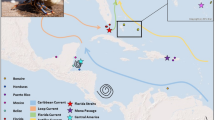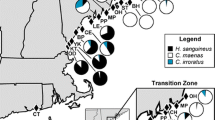Abstract
Rhithropanopeus harrisii are small, estuarine crabs native to the Atlantic and Gulf coasts of North America. They have become an invasive species, establishing populations on the west coast of the United States, Europe, Panama, and Japan. Reproducing populations are also established in freshwater reservoirs in Texas and on the Texas/Oklahoma border. In order to compare levels of genetic diversity within introduced reservoir populations with those of native estuary populations and to determine possible source populations and routes of colonization among Texas reservoir populations, we obtained mitochondrial DNA sequences from reservoirs and several estuaries along the Texas and Louisiana coast. Overall, genetic diversity within reservoirs was lower than within estuaries; however, some reservoirs exhibited relatively high levels of genetic diversity indicating that they were founded by numerous individuals or individuals from divergent source populations. In contrast, two genetically divergent reservoir populations had greatly reduced genetic diversity suggestive of extreme founder effects. All estuary and reservoir haplotypes formed a monophyletic group separate from Atlantic coast haplotypes, thus colonization of Texas reservoirs occurred from the Gulf Coast as expected based on geographic proximity. There was minimal DNA sequence divergence among Gulf Coast and reservoir haplotypes and a lack of phylogeographic structure among estuary populations. However, there was significant population divergence among some estuaries based on haplotype frequencies. Genetic differences among estuaries were subtle in most cases, preventing identification of source populations using mitochondrial DNA sequences.


Similar content being viewed by others
Availability of data and material
DNA sequences are available on GenBank.
References
Allendorf FW, Lundquist LL (2003) Introduction: population biology, evolution, and control of invasive species. Conserv Biol 1:24–30
Benjamini Y, Hochberg Y (1995) Controlling the false discovery rate: a practical and powerful approach to multiple testing. J Roy Stat Soc: Ser B (methodol) 57:289–300
Bilton DT, Paula J, Bishop JDD (2002) Dispersal, genetic differentiation and speciation in estuarine organisms. Estuar Coast Shelf Sci 55:937–952
Bock DG, Caseys C, Cousens RD, Hahn MA, Heredia SM, Hübner S, Turner KG, Whitney KD, Rieseberg LH (2015) What we still don’t know about invasion genetics. Mol Ecol 24:2277–2297
Boyle T Jr, Keith D, Pfau R (2010) Occurrence, Reproduction, and Population Genetics of the estuarine mud crab, Rhithropanopeus harrisii (Gould) (Decapoda, Panopidae) in Texas Freshwater Reservoirs. Crustaceana 83:493–505
Buitendijk AM, Holthuis LB (1949) Note on the Zuiderzee crab, Rhithropanopeus harrisii (Gould) subspecies tridentatus (Maitland). Zoologische Mededelingen 30:95–106
Burridge CP, Versace VL (2007) Population genetic structuring in Acanthopagrus butcheri (Pisces: Sparidae): does low gene flow among estuaries apply to both sexes? Marine Biotechnol 9:33–44
Burridge CP, Hurt AC, Farrington LW, Coutin PC, Austin CM (2004) Stepping stone gene flow in an estuarine dwelling sparid from southeast Australia. J Fish Biol 64:805–819
Casties I, Seebens H, Briski E (2016) Importance of geographic origin for invasion success: a case study of the North and Baltic Seas versus the Great Lakes–St. Lawrence River region. Ecol Evol 6:8318–8329
Costlow JD Jr, Bookhout CG, Monroe RJ (1966) Studies on the Larval Development of the Crab, Rhithropanopeus harrisii (Gould). I. The Effect of Salinity and Temperature on Larval Development. Physiol Biochem Zool 39:81–100
Cronin TW (1982) Estuarine retention of larva of the crab Rhithropanopeus harrisii. Estuary Coast Marine Sci 39:207–220
Cronin TW, Forward RB Jr (1986) Vertical migration cycles of crab larva and their role in larval dispersal. Bull Mar Sci 39:192–201
Estoup A, Guillemaud T (2010) Reconstructing routes of invasion using genetic data: why, how and so what? Mol Ecol 19:4113–4130
Excoffier L, Lischer HEL (2010) Arlequin suite ver. 3.5: A new series of programs to perform population genetics analyses under Linux and Windows. Mol Ecol Resour 10:564–567
Fitzgerald TP, Forward RB Jr, Tankersley RA (1998) Metamorphosis of the estuarine crab Rhithropanopeus harrisii: effect of water type and adult odor. Mar Ecol Prog Ser 165:217–223
Folmer O, Black M, Hoeh W, Lutz R, Vrijenhoer T (1994) DNA primers for amplification of the mitochondrial cyctochrome c oxidase subunit 1 from diverse metazoan invertebrates. Mol Mar Biol Biotech 3:294–299
Forward RB Jr (2009) Larval Biology of the Crab Rhithropanopeus harrisii (Gould): A Synthesis. Biol Bull 216:243–256
Fowler AE, Forsström T, von Numers M, Vesakoski O (2013) The North American mud crab Rhithropanopeus harrisii (Gould, 1841) in newly colonized Northern Baltic Sea: distribution and ecology. Aquat Invasions 8:89–96
Hall T (2011) BioEdit: an important software for molecular biology. GERF Bulletin of Biosciences 2:60–61
Hardouin EA, Andreou D, Zhao Y, Chevret P, Fletcher DH, Britton JR, Gozlan RE (2018) Reconciling the biogeography of an invader through recent and historic genetic patters: the case of topmouth gudgeon Pseudorasbora parva. Biol Invasions 20:2157–2171
Holland BS (2000) Genetics of marine bioinvasions. Hydrobiologia 420:63–71
Holm S (1979) A simple sequentially rejective multiple test procedure. Scand J Stat 6:65–70
Howells RG (1998) Xanthid crab in inland waters of Texas: a threat to unionids? Triannual Unionid Rep 16:16
Howells RG (2001) Introduced non-native fishes and shellfishes in Texas waters: an updated list and discussion. Management data series, 188. Texas Parks and Wildlife Dept., Inland Fisheries Division, Austin, TX
Iseda M, Otani M, Kimura T (2007) First record of an introduced crab Rhithropanopeus harrisii (Crusteacea: Brachyura: Panopeidae) in Japan. Jpn J Benthol 62:39–44
Ivanova NV, Dewaard JR, Hebert PD (2006) An inexpensive, automation-friendly protocol for recovering high-quality DNA. Mol Ecol Notes 6:998–1002
Jones LL (1940) An introduction of the Atlantic crab into San Francisco Bay. Proc Sixth Pac Sci Cong 3:485–486
Kelly DW, Muirhead JR, Heath DD, Macisaac HJ (2006) Contrasting patterns in genetic diversity following multiple invasions of fresh and brackish waters. Mol Ecol 15:3641–3653
Kumar S, Stecher G, Li M, Knyaz C, Tamura K (2018) MEGA X: Molecular Evolutionary Genetics Analysis across computing platforms. Mol Biol Evol 35:1547–1549
Laughlin RB, French W (1989) Differences in responses to factorial combinations of temperature and salinity by zoeae from two geographically isolated populations of the mud crab Rhithropanopeus harrisii. Mar Biol 102:387–395
Lee CE (1999) Rapid and repeated invasions of fresh water by the copepod Eurytemora affinis. Evolution 53:1423–1434
Lee CE (2002) Evolutionary genetics of invasive species. Trends Ecol Evol 17:386–391
Leigh JW, Bryant D (2015) PopART: Full-feature software for haplotype network construction. Methods Ecol Evol 6:1110–1116
Lin Y, Greatbatch RJ, Sheng J (2010) The influence of Gulf of Mexico Loop Current intrusion on the transport of the Florida Current. Ocean Dyn 60:1075–1084
Maitland RT (1874) Naamlijst van Nederlandsche Schaaldieren. Tijdschr. Nederl. Dierk, Ver 1:228–269
McMillen-Jackson AL, Bert TM (2003) Disparate patterns of population genetic structure and population history in two sympatric penaeid shrimp species (Farfantepenaeus aztecus and Litopenaeus setiferus) in the eastern United States. Mol Ecol 12:2895–2905
McMillen-Jackson AL, Bert TM (2004) Genetic Diversity in the mtDNA control region and population structure in the pink shrimp Farfantepenaeus duorarum. J Crustac Biol 24:101–109
Milá B, Van Tassell JL, Calderón JA, Rüber L, Zardoya R (2017) Cryptic lineage divergence in marine environments: genetic differentiation at multiple spatial and temporal scales in the widespread intertidal goby Gobiosoma bosc. Ecol Evol 7:5514–5523
Moore CS, Ruocchio MJ, Blakeslee AM (2018) Distribution and population structure in the naked goby Gobiosoma bosc (Perciformes: Gobiidae) along a salinity gradient in two western Atlantic estuaries. PeerJ 6:e5380
Paiva F, Barco A, Chen Y, Mirzajani A, Chan FT, Lauringson V, Baltazar-Soares M, Zhan A, Bailey SA, Javidpour J, Briski E (2018) Is salinity an obstacle for biological invasions? Glob Change Biol 24:2708–2720
Patton T, Newman C, Sager C, and Mauck M (2010) Occurance of Harris mud crab Rhithropanopeus harrisii in Oklahoma (Lake Texoma), the furthest inland report to date. Proc Okla Acad Sci pp 75–82
Peterson C (2006) Range expansion in the northeast Pacific by an estuary mud crab–a molecular study. Biol Invasions 8:565–576
Projecto-Garcia J, Cabral H, Schubart CD (2010) High regional differentiation on a North American crab species throughout its native range and invaded European waters: a phylogeographic analysis. Biol Invasions 12:253–263
Roche DG, Torchin ME (2007) Established population of the North American Harris mud crab, Rhithropanopeus harrisii (Gould 1841) (Crustacea: Brachyura: Xanthidae) in the Panama Canal. Aquat Invasions 2:155–161
Rodriguez G (1963) The intertidal estuarine communities of Lake Maracaibo, Venezuela. Bull Mar Sci 13:197–218
Roman J, Darling JA (2007) Paradox lost: genetic diversity and the success of aquatic invasions. Trends Ecol Evol 22:454–464
Smith JA (2008) Vorticity and Divergence of Surface Velocities near Shore. J Phys Oceanogr 38:1450–1468
Stern DB, Lee CE (2020) Evolutionary origins of genomic adaptations in an invasive copepod. Nat Ecol Evol 4:1084–1094
Tepolt CK, Blakeslee AM, Fowler AE, Darling JA, Torchin ME, Miller AW, Ruiz GM (2020) Strong genetic structure in a widespread estuarine crab: A test of potential versus realized dispersal. J Biogeogr 47:2532–2543
Turoboysk K (1973) Biology and ecology of the crab Rhithropanopeus harrisii ssp. tridentatus. Mar Biol 23:303–313
Williams AB (1984) Shrimps, lobsters, and crabs of the Atlantic coast of the eastern United States. Smithsonian Institution Press, Washington, DC, Maine to Florida
Winkler G, Dodson JJ, Lee CE (2008) Heterogeneity within the native range: population genetic analyses of sympatric invasive and noninvasive clades of the freshwater invading copepod Eurytemora affinis. Mol Ecol 17:415–430
Acknowledgements
We wish to thank David Buzan and Sam Kieschnick for assistance collecting specimens, Tarleton State University for funding, and anonymous reviewers for their constructive criticism.
Funding
Tarleton State University.
Author information
Authors and Affiliations
Corresponding author
Ethics declarations
Conflicts of interest
The authors declare that they have no conflict of interest.
Additional information
Publisher's Note
Springer Nature remains neutral with regard to jurisdictional claims in published maps and institutional affiliations.
Appendix: Locality information for specimens collected as part of this study
Appendix: Locality information for specimens collected as part of this study
Reservoirs
Squaw Creek Reservoir (March through August 2011): safe shut-down impoundment adjacent to reservoir (32.2957785, − 97.7868482). Lake Whitney (March 2011): Lake Whitney State Park on Farm to Market Road 1244 in a bay on the northern boundary of the park (31.923169, − 97.3749368). Lake Texoma (June 2011): west boundary of The University of Oklahoma Biological Station on the north shore of Lake Texoma east of State Highway 377 (33.8802968, − 96.8022547). Lake Braunig (July 2011): Lake Braunig Park, 17,500 Donop Road, San Antonio, Texas (29.2543883, -98.3920036).
Estuaries
Nueces River (July 2008): bridge of Interstate Highway 37 over the Nueces River in Patricio County (27.8919027, − 97.6292523). The Nueces River flows into Nueces Bay. Mission River (July 2008): at the intersection of Farm to Market Road 2678 crossing the Mission River in Refugio County (28.1834974, − 97.2141456). The Mission River flows into Mission Bay and then into Copano Bay and then into Aransas Bay. Garcitas Creek (July 2008): bridge of Farm to Market Road 616 over Garcitas Creek on the border of Victoria and Jackson Counties (28.7776815, -96.6995914). Garcitas Creek flows into Lavaca Bay then into Matagorda Bay. Lavaca River (July 2008): bridge of Farm to Market Road 616 crossing the Lavaca River in Jackson County (28.8316365, − 96.5790748). The Lavaca River flows into Lavaca Bay and then into Matagorda Bay. Tres Palacios River (July 2008 and June 2017): bridge of Farm to Market Road 521 over the Tres Palacios River in Matagorda County (28.7861209, − 96.1511496). The Tres Palacios River flows into Tres Palacios Bay and then into Matagorda Bay.
Rights and permissions
About this article
Cite this article
Huebner, T.S., Boyle, T.M. & Pfau, R.S. Population genetics of estuary and reservoir populations of Harris mud crabs, Rhithropanopeus harrisii, in Texas and Oklahoma. Biol Invasions 23, 3369–3382 (2021). https://doi.org/10.1007/s10530-021-02580-x
Received:
Accepted:
Published:
Issue Date:
DOI: https://doi.org/10.1007/s10530-021-02580-x




